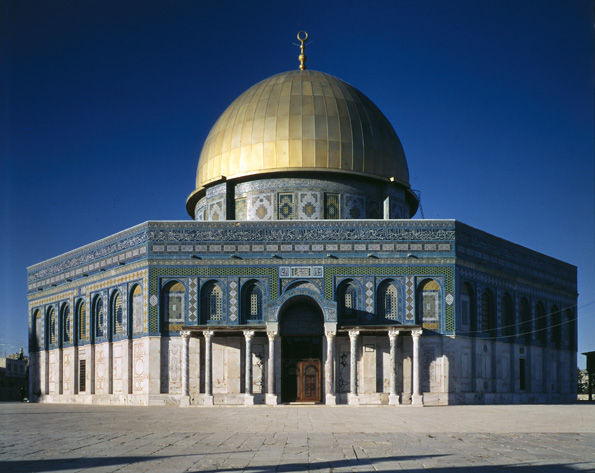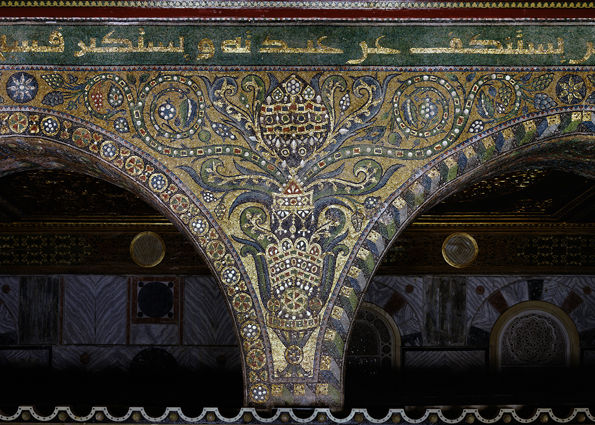Dome of the Rock, Jerusalem, completed 691/692. © Scala / Art Resource
Originally constructed between 688 and 692 under the rule of Abd al-Malik, whom Yitzchak introduced in the previous post, the Dome of the Rock is one of the most emblematic architectural landmarks in the history of Islamic culture. On the one hand, the monument carries a unique and unifying significance for Islamic religious communities over broad temporal and geographic scopes; on the other hand, it reflects the far-reaching extent of intercultural contacts and dialogues that have shaped such Islamic communities over time, on a local level.
The edifice is situated on top of the Temple Mount (the site of Solomon's and Herod's Temples) in Jerusalem, framing a rock that holds sacred significance for all three monotheistic religions. In the Judeo-Christian tradition this rock marks the place where Abraham came to sacrifice Isaac; for Muslims, it came to be thought of as the site of the miraj, the Prophet Muhammad's miraculous ascension to heaven with the angel Gabriel and his faithful horse Buraq. Although the monument's intended function continues to be debated, the Dome of the Rock has historically functioned—and continues to serve—not as a mosque but as a shrine, and one of the most important sites of pilgrimage for Muslims worldwide.
Dome of the Rock, Jerusalem, completed 691/692; detail of the interior mosaics showing hanging crowns, jewelry, and inscriptions. © Said Nuseibeh
At the same time, as an architectural monument, the building attests to the complexity of crosscultural, historical interactions that have shaped it. The Dome of the Rock is a perfect example of Islamic interaction with Byzantine artistic and architectural traditions. The overall form of the architectural dome follows the Byzantine model of churches and martyriums (structures designed to house relics); and the mosaics decorating its interior draw extensively on Byzantine mosaic techniques and aesthetics in their execution of vegetal motifs (while combining them with Sasanian iconographic elements). Thus, although the Quranic inscriptions adorning the Dome of the Rock promote the virtues of the Islamic faith over Christianity, the architectural and decorative programs are heavily indebted to the Byzantine Christian artistic tradition, which they recombine and reinterpret to create a triumphal message.
Over the course of many centuries, the Dome of the Rock continued to be altered in form and function, and its identity serially transformed through successive restoration projects. Each new group that conquered Jerusalem laid claim to the monument in its own way: from the Abbasid caliph al-Mamun's added inscriptions claiming credit for the construction of the edifice; to the Crusaders' use of the Dome as a church; to the Ottoman Sultan Suleyman's massive restoration program that enveloped the building's exterior in a contemporary and quintessentially Ottoman program of Iznik tilework.
In 1994, Jordan and Saudi Arabia donated eighty kilograms of gold to redo the exterior of the gold dome. The Dome of the Rock is a living monument to the complicated and layered network of inter-dynastic and inter-cultural connections that underlie our commonly more linear historical narratives.

